Photos with this report (click to enlarge) | |||
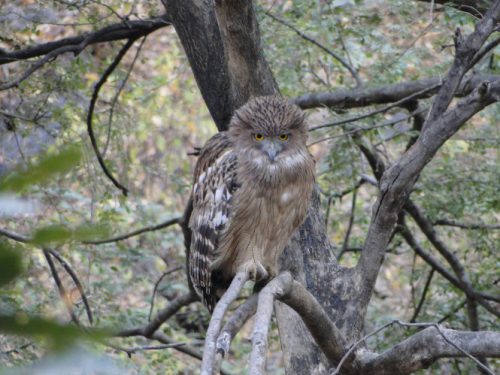 Brown Fish Owl |
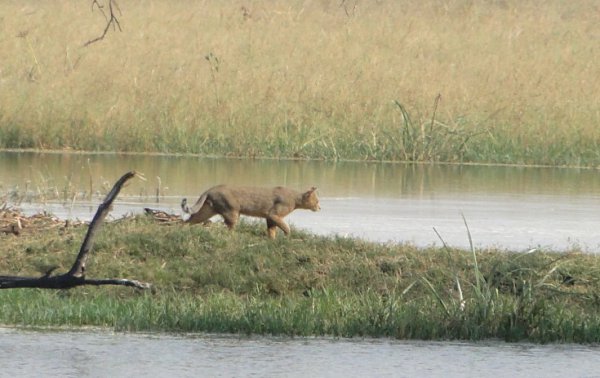 Jungle Cat |
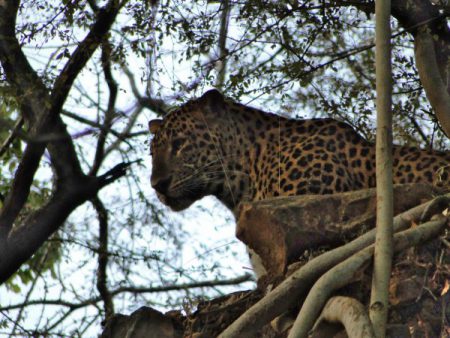 Leopard |
|
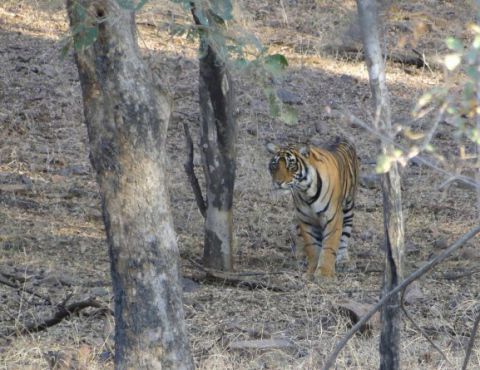 Tiger |
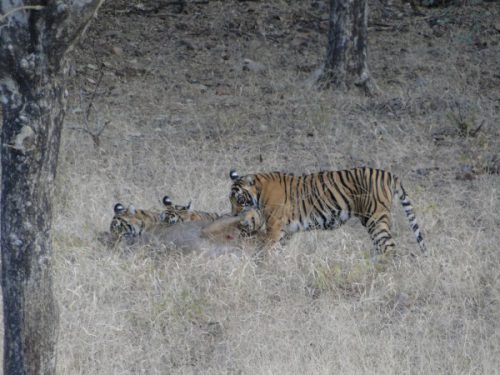 Tiger |
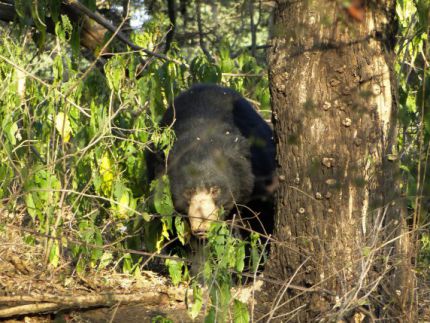 Sloth Bear |
|
Background
Introduction
This report outlines a three week trip which I undertook with my wife, Alison Rowntree, in northern India. Although we were keen to maximise birding opportunities, the overriding priority was to see Tigers, so a significant amount of time was spent in two Tiger parks. We flew into Delhi and from here, after a day trip to Sultanpur, travelled to the Chambal River for a boat safari, then to Agra to see the famous Taj Mahal, followed by the world renowned bird reserve at Bharatpur. Next we visited the Tiger parks of Ranthambhore and Bandhavgarh before returning to Delhi.
We booked flights through DialAFlight, and everything else via Wild About Travel, a British company run by Jo Thomas, who works in conjunction with Untold India. She organised all our transport, accommodation and guides. Most arrangements went well. Jo is a birder and her experience of India means she was able to give lots of good advice. In particular, in response to our priority of Tigers, she advised us to include Ranthambhore, as well as Bandhavgarh, in our itinerary which proved an excellent move.
I’m also grateful to Steve & Penny Young who visited similar areas of India with their family six months before our trip, and provided lots of help and advice.
Visas are required to visit India from the UK and although e-visas are supposed to make things simple, the process is torturous with a clunky website, so ensure you apply well before your visit. Jo provided some tips on applying.
India is a fascinating country. Sometimes described as “an assault on the senses”, the cultural differences can prove challenging to some westerners. Constant expectations for tips, blatant staring, over-attentive service, questions about your age and religion, crazy driving and defecating in public all take a bit of getting used to! We came home saying “wow, what an experience!”
This is an independent report, not linked to any company or third party provider.
For further information please feel free to contact me - peteraley@msn.com
Wildlife & Safaris
Bengal Tiger is famous as the pinnacle of India’s wildlife, and to maximise our chances of seeing them, we booked a total of 13 safaris. Most of these were in exclusive jeeps, the advantage of which is you are free to stop as often as you like to look at birds, something other visitors may be unhappy to do. However, at Ranthambhore, which is the more expensive than Bandhavgarh, our first two safaris were in a shared jeep, to keep the cost down a bit. Safaris are in open-topped jeeps (known as “Gypsies”) and be warned, the early morning ones are extremely cold so make sure you take warm clothes – we used hats and gloves as well as several layers of jackets. Blankets are provided.
India, of course, has much more than Tigers to offer, with a number of other highly sought after large mammals and a fantastic range of birds including many endemics. We had a very successful trip, seeing 12 Tigers, a range of other large mammals and 236 species of bird. Many of the birds overlap in terms of species and / or families with Europe, making the birding relatively straight forward for European visitors. However the country is huge, so it is only possible to see a proportion of its’ birds in a few week visit. Summer tends to be too hot and wet to visit this part of India so most birders will want to go between about October and April.
We used a variety of wildlife guides. Those at Sultanpur, Bharatpur and Chambal River were excellent. Those provided by the National Parks on the jeep safaris (compulsory) were of variable quality with some being quite poor.
As ever, the Fatbirder website, gives a good overview of India’s birdlife.
We used the Helm field guide Birds of the Indian Subcontinent (Grimmett, Inskipp & Inskipp 2011) which proved pretty good and Jo Thomas provided a checklist of birds in the regions we visited.
Photos, in addition to those with this report, can be found on Surfbirds (World Birding and Mammals galleries).
Details of the more interesting birds and mammals we saw are included in the daily accounts below with numbers aimed at providing some indication of abundance rather than always being exact counts.
Travel & Accommodation
Our flights were with the excellent Emirates, Heathrow to Delhi, return.
Our ground travel consisted of a combination of private cars with drivers, trains and a rickshaw! You only need to take a glance at the driving conditions and lack of road markings in and around large cities, to understand that self-drive is not an option.
All the hotels and lodges we used were of pretty good quality and my reviews of these can be found on Trip Advisor ("PlymouthPete19").
Food, Tipping & Money
Almost everywhere we went, the food was delicious. Even in more up market hotels, the emphasis is on traditional Indian cuisine so don’t expect western-style food routinely alongside local choices. Catering for vegetarians is fantastic; typically a range of choices on the hot buffet will include just one dish on the end marked “non-vegetarian”!
Tipping is a national institution with everyone providing you with a service expecting a tip. This can soon add up, so factor it onto your budget. Jo Thomas provided information on recommended amounts for tips and rates for e.g. for rickshaws and porters.
Visitors are not allowed to take rupees into or out of India, so money needs to exchanged when you arrive. The easiest (if not safest) way is to take cash. We got a reasonable rate at a money exchange in Agra and only slightly worse at one of the hotels. Avoid the airport.
Daily accounts
15th November: Delhi
Arrived Delhi airport early morning, met our driver and taken to Justa The Residence, Panchsheel which we had booked for two nights. The journey gave us our first taste of the crushing Delhi traffic and sightings of a few common birds - Black Kites, Common Mynas, Jungle Babblers and House Crows.
Apart from a short walk, the rest of the day was spent relaxing in the hotel, avoiding the heavy pollution which had beset Delhi over the preceding weeks.
16th November: Sultanpur
Straight after breakfast we were driven to Sultanpur, a relatively new National Park bird sanctuary (normally an hour’s trip but took twice as long due to heavy traffic).
Accompanied by our bird guide, Gajendra, this provided an excellent introduction to India’s bird life with hundreds of ducks (some common in the UK) and storks as well as a good selection of other water birds and passerines.
Highlights were one of the localised Sind Sparrow, a pair of huge and magnificent Sarus Cranes (with another pair glimpsed from the car on wetlands shortly after we left), our only Bonelli’s Eagle (adult) and Common Quail (2) of the trip, a pair of impressive Black-necked Storks with three young in a nest, 50+ of the colourful Painted and two Wooly-necked Storks.
Other sightings which of species we subsequently saw regularly at most sites included: Grey Francolins, Indian Peafowls, Indian Pond Herons, Little Cormorants, Red-wattled Lapwings, Green-footed Pigeons, Ring-necked Parakeets, White-throated Kingfishers, Hoopoes, Black-rumped Flameback, Long-tailed Shrike, Black Drongos, Rufous Treepies, Red-vented Bulbuls, Plain Martins, Wire-tailed Swallows, Chiffchaffs (tristis), Hume’s Leaf and Greenish Warblers, Lesser Whitethroats (blythi) Ashy and Plain Prinias, Common Tailorbirds, Large Grey Babblers, Oriental White-eyes, Bank Mynas (en route), Oriental Magpie and Indian Robins, Black Redstarts (eastern), Siberian Stonechats, Pied Bushchats, Red-breasted Flycatchers, Purple Sunbirds, Blue Bulls (or Nilgais), Five-striped Palm Squirrels and Rhesus Macaques.
We also recorded: Knob-billed (6) and Indian Spot-billed Ducks (3), Red-naped Ibis, Intermediate Egret (2), Oriental Darter (3), Great Spotted Eagle, Shikra, Purple Swamphens, White-tailed Plover, Pheasant-tailed Jacana, Spotted Owlet (6), Coppersmith Barbet, Yellow-browned Pied Woodpecker, Common Woodshrike (9), Bay-backed Shrike, Ashy Drongo, Asian Pied Starling (2), Bluethroat, Red Avadavat (6), Indian Silverbill, Citrine Wagtail (12) and Olive-backed Pipit (5).
By the end of the day we’d notched up 86 species (including a handful en route) but there was no sign of the hoped-for Indian Courser.
17th November: Chambal Safari Lodge
Left Delhi by car, seeing four Black-winged Kites and three Egyptian Vultures en route, and after a six-hour drive (including two brief stops) arrived at Chambal Safari Lodge early afternoon, for a three-night stay.
After lunch, we toured the excellent lodge grounds with one of their wildlife guides. He quickly located a trio of roosting owls – a Brown Hawk Owl, two Indian Scops Owls and three Spotted Owlets, all giving great views and looking relaxed on their perches in the trees. Amongst a mixed flock of Baya Weavers, Indian Silverbills, Scaly-breasted Munias and Chestnut-shouldered Petronia, we found a male Black-headed Munia, apparently only the second record for the site! Other highlights were our first Golden Jackals (3) including one asleep, and two beautifully colourful Plumb-headed Parakeets. Dozens of huge and noisy Flying Foxes were roosting near our room.
18th November: Chambal River & Safari Lodge
Driven to the Chambal River in the morning and before embarking on our half day boat trip, a search around the shore by the launch spot produced a few birds notably two Sand Larks.
The boat trip provided a great opportunity to get views of a wide variety of species, land birds as well as water dwellers. We quickly came across three each of River and the striking Black-bellied Terns, one of the latter watched resting on a sand bar. Other highlights were: several parties of Great Thick-knees (5); distinctive Asian Openbills (6); our highest trip count of Red-naped Ibises (6); fascinating Gharials with their narrow snouts side-by-side with huge Marsh Crocodiles; and several sightings of the scarce Indian River Dolphin surfacing. A Pallas’s Gull gave an all too brief and distant appearance down the river and a Long-legged Buzzard flew by, however we had no luck in finding Indian Skimmer nor Small Pratincole.
Other birds seen on the boat trip or shore near the launch spot included: Lesser Whistling-duck (40), Striated Heron, Black-winged Kites, Western Osprey (3), Shikra (2), Egyptian Vulture (3), Peregrine (“Shaheen Falcon”), River Lapwings, Temminck’s Stint (3), Bronze-winged Jacana (4), Greater Coucals, Pied Kingfishers, Southern Grey Shrike, Desert Wheatear, Blue Rock Thrush, Citrine (2), White and White-browed Wagtails, Tawny Pipit (3), Crested Lark (2) and a variety of Turtles.
Back at the Lodge, Grey Mongoose (2) appeared, our guide expertly found three Barred Buttonquail lurking under bushes, and in nearby fields, two Yellow-wattled Lapwings. After dark Alison found a Jungle Cat just outside our room but it slipped away before I could get on to it. However the guide came and found us to show us a superb Common Palm Civet in torch light up a tree near the restaurant.
Other species we recorded around the Lodge included Red-necked Falcon, Laughing Doves, Little Swifts, Indian Grey Hornbill (10), Brown-headed & Coppersmith Barbets, Wryneck, Grey-headed Canary Flycatcher (2), Yellow-eyed Babbler (6), Asian Pied and Brahminy (4) Starlings, Olive-backed Pipit (4), Common Rosefinch (6), Red-headed Bunting (6) and some Indian Hares.
19th November: Agra
After breakfast, our driver took us to Agra where we were met by a licensed local guide who gave us a tour of the impressive Taj Mahal, one tourist destination we weren’t going to miss! Bird-wise, as well as the Black Kites and Eqyptian Vultures overhead, the river here (viewed from behind the Taj) teemed with wetland species including Painted Storks, Ruddy Shelducks, Great Cormorants and our only Whiskered Terns of the holiday. Unfortunately however, we saw no Pallas’s Gull.
After lunch in Agra, we were taken to Bharatpur where we said good bye to our driver, checked into the Sunbird Hotel for five nights and spent the rest of the day relaxing.
20th November: Bharatpur
Spent all day on foot in Keoladeo National Park (entrance just five minutes walk from the Sunbird) again guided by Gajendra. The Park consists of large expanses of water, as well as some drier areas. Gradually diminishing levels of water have become an issue in recent years leading to breeding failures for some species. Parts of the park can be accessed from a long central track with a number of smaller paths extending from it. Rickshaws can be used on the track but not the smaller paths; vehicles are not allowed.
The wetlands contained impressive numbers of ducks, waders, herons, egrets, cormorants and kingfishers, as well a range of passerines such as Blyth’s Reed Warblers, Lesser Whitethroats (blythi), Red-breasted Flycatchers and Citrine Wagtails. Greater Spotted Eagles (15) proved relatively common, some showing well perched. Sambar and Spotted Deer were also common.
Today, Gajendra pointed out a pair of Dusky Eagle Owls roosting in a small tree above the water, several Indian and one Oriental Scops Owl and some Spotted Owlets. The latter were seen regularly here (10+ in total) but the Oriental was subsequently flushed by a photographer and not seen again during our visit. During our lunch break by the small shop, Alison found our only Indian Nightjar of the trip – roosting in trees above our picnic table. Top skills by Gajendra produced views of a male Black Bittern and a Moustached Warbler (scarce here) both skulking in path-side bushes. By the end of the day we had also enjoyed views of no less than three of the four pairs of magnificent Sarus Cranes which we saw in total at this site.
21st November: Bharatpur
All day in the Park again, this time using a Rickshaw which we hired outside our hotel. (Rickshaw prices are regulated by the Park authorities and supposed to be 150 rupees an hour - plus tip - but on return, our driver tried demanding more. I resisted!)
Our route took us on the track beyond the shop and here Alison spotted a Jungle Cat (scarce in the area) which we enjoyed good views of wandering along a small spit and eventually dashing off along the track. As well as this undoubted highlight of the day, we also got close views of a beautiful Orange-headed Ground Thrush near the temple, and saw Hog Deer – rare here.
22nd November: Bharatpur
The morning spent in dry areas around Kumher, a relatively short drive outside Bharatpur. Here we connected with one of our target – Indian Courser – eventually amassing 14 of these superbly marked birds. Other notable sightings in this area included both Isabelline (1) and Desert (3) Wheatears, Southern Grey (4), Isabelline & Bay-backed (2) Shrikes, Indian Thick-knee (6), Ashy-crowned Sparrow Lark (40) and good views of a small pack of Golden Jackals. However the biggest surprise of all was finding a (female) Stoliczka’s Bushchat, well outside its’ NW India range and apparently the first properly documented record for this area! Before returning for lunch we stopped in Bharatpur town where a rather unsavoury ditch produced two Greater Painted-snipe well camouflaged in the vegetation.
Yellow-wattled Lapwing (8+), Laughing Doves, Greater Coucals, Little Swifts, Indian Jungle Crows, Indian Bushlark, Greater Short-toed Larks, Bluethroat, Brown Rock Chat, Tawny Pipit (20) and Crested Lark (8) were also seen in this area.
Back in the Park for the afternoon (on foot) and beside the track we eventually got great views of a superb male Siberian Rubythroat (a species which is getting quite hard to see here) as well as better views of both Black Bittern (female) and two roosting Indian Scops Owls.
23rd November: Bharatpur
A morning’s walk in the Park. Four Barred Buttonquail showed in the open beside the track to the temple early on and Wryneck and Yellow Wagtail (lutea) were also new species for us at the site.
Afternoon spent relaxing at the Sunbird.
Other birds seen in the Park included: Great White Pelican, Bar-headed Goose (12), Ruddy Shelduck (6), Lesser Whistling-duck (150), Knob-billed Duck (8), Cotton Pygmy Goose (2), Indian Spot-billed Duck (25), Ferruginous Duck (12), Painted Stork, Asian Openbill (2), Wooly-necked (2) & Black-necked (1) Storks, Black-headed (20) & Glossy (12) Ibises, Eurasian Spoonbill (20), Black-crowned Night (4+), Striated (2) & Purple Herons, Intermediate Egrets, Indian Cormorant (12), Oriental Darters, Oriental Honey-Buzzard (3), Black-winged Kite (2), Egyptian Vulture (6), Marsh Harriers, Shikra (3), Steppe Eagle (2+), White-tailed Plover (6+), Marsh Sandpiper, Pheasant-tailed (1) and Bronze-winged (8) Jacanas, Green Sandpiper (100+ in one flock), Laughing Doves, Plumb-headed Parakeet (8), Greater Coucals, Common Hawk Cuckoo, Little Swifts, Pied Kingfisher (4), Green Bee-eater (6), Indian Grey Hornbill (2), Brown-headed (2) & Coppersmith (2) Barbets, Yellow-crowned Pied Woodpecker (2), Indian Jungle Crows, Zitting Cisticola (2), Common Babbler (8), Yellow-eyed Babbler (8+), Asian Pied & Brahminy Starlings, Rosy Starling, Bluethroat (12+), Brown Rock Chat (2), Chestnut-shouldered Petronia, Red Avadavat (3), and Black-headed Munia (4).
Other mammal sightings included: Hanman Langur, Wild Boar, Golden Jackal and Flying Fox. We also saw a number of Turtles.
24th November: Bharatpur to Ranthambhore
After a later breakfast we were driven to Bharatpur station where after helping us on to the train, we said goodbye to Gajendra. A porter, hired at the station for a fixed rate, took our bags into our carriage (2nd class air conditioned). This proved to be a sleeper with bodies still strewn out all over the place including one of our seats! Our other seat was a high bunk in a different place. Eventually however, we managed to negotiate somewhere to sit together and about two hours later, arrived at Sawai Madhopur station. Here our driver met us on the platform and after a short drive, we arrived at the Pugmark, close to Ranthambhore National Park, where we would spend the next three nights.
The afternoon was spent exploring the hotel’s grounds which proved pretty good for birds. Species seen in the Pugmark grounds, or nearby, during our stay included: Common Tailorbird, Purple Sunbird, Common Babbler, Plumb-headed Parakeet, Coppersmith’s Barbet, Common Woodshrike, Barred Buttonquail, Green Bee-eater, Rufous Treepie, Spotted Dove, Common Iora, Long-tailed Shrike, Ashy Prinia, Oriental White-eye, Red-breasted Flycatcher, Great Thick-knee, Hume’s Leaf Warbler, Chestnut-bellied Sandgrouse, Indian Bushlark, Black-winged Kite, Tawny Pipit, Tree Pipit, Wryneck, Southern Grey Shrike and Variable Wheatear.
25th November: Ranthambhore
Up for an early breakfast and a pre-dawn start to our Tiger safaris. We were picked up by a jeep which we shared with two other visitors, and taken to zone 3 in Ranthambhore National Park. A limited number of vehicles are allocated to each zone, each morning and afternoon and you are not allowed into another zone however good the Tiger sightings might be! Although the driver changed each trip, we had the same guide for our whole stay here.
In recent years, the chances of seeing Tigers in Ranthambhore have improved significantly so we set off in keen anticipation. Within 10 minutes of entering the Park, alerted by the alarm calls of langurs and deer, the guide asked the driver to stop and, along with a few other jeeps, we scanned the undergrowth hoping for Tiger. Suddenly a wave of excitement rippled through the assembled hopefuls and someone said “Leopard”. There, only 20 metres or so away, this magnificent creature was looking down on us from a small cliff edge. Leopards are much less frequent here than Tigers so we couldn’t believe our luck; what a start to our safaris!
Zone 3 has the best scenery on the Park, including vast lakes and the iconic ex-hunting lodge and fort which feature in many of the films and pictures of this famous reserve. In common with other zones, Spotted and Samba Deer are everywhere providing ample food for hungry striped predators. We drove around this beautiful setting listening for more alarm calls and looking for fresh Tiger tracks, but despite hearing the calls and seeing quite a few paw prints, we failed to find our target.
In the afternoon we visited zone 2, again by shared jeep, but once more failed to find Tiger. However a bit of birding produced Indian Scops Owl (2), Black Stork (2), White-capped Bunting (3) and Brown-capped Pygmy Woodpecker.
26th November: Ranthambhore
Another early start for a morning in zone 1, apparently the best one for Tigers, now in an exclusive jeep which we had for the rest of our stay. By the end of our session however, we’d drawn a blank again and missed a Sloth Bear seen by some other jeeps. We were beginning to worry that we’d never see a Tiger but were very pleased that we’d adopted the tactic of booking lots of safaris to narrow the odds. Even fantastic views of two characterful Brown Fish Owls, and - by the lake - a colourful Stork-billed Kingfisher, a perched Crested Serpent Eagle and our first Alexandrine Parakeets (8+), did not compensate.
With the brief to our guide to continue focusing on finding Tiger, we were taken into zone 3 again. Here reports of a Tiger seen wandering into long grass by the lake, quickly filtered through the guides’ grapevine. Gradually the numbers of jeeps and bigger trucks full of Tiger hopefuls, increased as we staked the area out. Our guide and driver were confident the stripy beast was still in there but probably wouldn’t emerge until the cool of early evening. It was going to be a race against time as strict rules dictate the time vehicles must leave the Park.
After waiting an hour or so, suddenly an air of excitement broke the tranquillity and in a cloud of dust, we sped off down the track. Surely this time we were going to connect with Tiger. But no; instead we picked up our binoculars to view a big black lump – a Sloth Bear with head down digging for termites! Notorious for being shy and with noise minimisation not on the agenda for most jeeps, we were convinced as soon as it put its’ head up, it would be off. But incredibly it looked up and walked straight towards us, eventually passing within a few metres of the assembled vehicles. What a view! We later discovered it was the breeding season and this male had spotted a female on the other side of the track.
Sloth Bears, as well as being shy, are far from common, so we counted ourselves very lucky to have enjoyed such good views. But there was another big mammal that we were getting increasingly desperate to see. Back at our stake out, the waiting game continued. Suddenly a shout went up and another top speed dash to get in position – and there at distance beside the lake, at last, our first Tiger (named “Arrowhead”)! Elated to have finally succeeded but equally frustrated at the distance and brevity of views, we sped off to meet the exit time required.
27th November: Ranthambhore
Yesterday’s Tiger had merely whetted our appetite for more, as we took the longer drive this morning to zone 6. Just five minutes after entering the Park our driver hit the accelerator and just a few hundred metres further, looking down on us from a small cliff edge were not one, but two Tigers! These 12 month old sisters gave very close views for several minutes before wandering off into the bush. That was more like it!
Applying their knowledge, our driver and guide opted to take a track up the slope opposite the area they had disappeared into and we scanned from distance until Alison said “Tigers” – the two sisters had joined Mum (“Ladali”) and as we watched them rest and stroll around, Dad (“Kumbha”) appeared too. Prolonged views through binoculars revealed them interacting, and tree-scratching before they slowly disappeared up the slope. Superb!
We then toured other parts of the zone and enjoyed some great views from a view point but saw little else of note before returning to the Pugmark.
Our final afternoon in the Park was in zone 1. A long dash in response to a report of a Tiger on the track resulted in a near miss. But our guide was convinced that somewhere in the nearby bush above a watering hole, Tiger sisters were resting and may eventually come out to drink. After a long wait with the trail having gone cold, we decided to revisit the lake for a bit of birding. Here, we had better views of Crested Serpent Eagle but saw nothing new and decided to return to the watering hole.
All was quiet as we settled down to watch a drinking Samba and enjoy our last couple of hours in the Park. After only 10 minutes or so, the Samba looked alert and out of the vegetation came a roar – a Tiger was in there. Soon one of the 20 month old sisters wandered into view and sat down right in front of us giving prolonged views. Incredibly this was not the best of it. Suddenly there was commotion in the undergrowth and our young Tiger was quickly joined by her two sisters who killed a Samba Deer right in front of us! Our final sighting of Tiger was a memorable one with these three awesome creatures sharing their prey at close range. Witnessing a kill is extremely unusual and even the guide was excited and taking pictures. A fitting end to a fantastic visit to Ranthambhore.
Other sightings in Ranthambhore included: Painted Spurfowl (8), Ruddy Shelduck (6), Lesser Whistling-duck (10), Painted Stork, Black-crowned Night (2), Striated (2) & Purple (1) Herons, Intermediate Egrets, Oriental Darters, Western Osprey (2), Black-shouldered Kite (3), Indian Vulture, Great Thick-knee (4), Marsh Sandpiper (2), River Tern (6), Spotted Doves, Plumb-headed Parakeets, Spotted Owlet (2), Little Swifts, Pied Kingfisher (4), Green Bee-eaters, Common Iora (6), Small Minivet (6), White-bellied Drongo (4), White-browed Fantail (8), Indian Jungle Crows, Grey-headed Canary Flycatcher, Dusky Crag Martin (12+), Common Babbler (8), Brahminy Starling (4), Brown Rock Chat (3), Chestnut-shouldered Petronia, Indian Silverbill, Citrine Wagtails, White-browed Wagtail, Wild Boar, Ruddy Mongoose, Flying Fox and Marsh Crocodile.
After returning to our hotel to freshen up and pick up a packed dinner, we were dropped off at the station and once again, shown to our carriage by the porter. We had booked a first class sleeper and, with beds only allocated a few hours before departure we weren’t quite sure what to expect. Thankfully we were in a compartment for two and after our meal, we made up our beds and locked the door for the long overnight journey to our next destination.
28th November: Bandhavgarh
Arrived at Katni early morning and picked up from the platform by our driver. After a two-hour drive we got to the Nature Heritage Resort, close to Bandhavgarh National Park, and checked in for five nights. With a couple of hours to spare before our first safari, we did a bit of birding around the Lodge.
Birds seen in Nature Heritage Resort grounds, or nearby, during our stay, included: Greenish Warbler, Coppersmith’s Barbet, Purple Sunbird, Small Minivet, Hume’s Leaf Warbler, Tickell’s Blue Flycatcher, Golden-fronted Leafbird, Black Redstart, Indian Grey Hornbill, Jungle Owlet, Tawny-bellied Babbler, Alexandrine Parakeet, Oriental White-eye, Yellow-footed Green Pigeon, Green Bee-eater, Common Woodshrike, White-rumped Munia, Indian Pond Heron, Black-hooded Oriole, Plumb-headed Parakeet, Long-tailed Shrike (including one of race tricolor) and Sulphur-belled Warbler. Hanuman Langurs were also regularly seen here: entertaining and disruptive in equal measures!
Overlooked by an ancient fort high on the hill, Banghavgarh National Park offers a variety of vegetation and some water attracting a variety of wildlife. This afternoon we were picked up outside the Lodge and taken to zone 2 in an exclusive jeep which we had booked for the entire stay. Although we heard a few alarm calls, Tigers proved elusive. We did however come across a few birds including White-eyed Buzzard, and our first of eight Painted Spurfowl and of 20 Red Jungle Fowl.
Unfortunately arrangements for guides and safaris did not go smoothly at Bandhavgarh. We were supposed to have the Nature Heritage Resort’s wildlife guide every day for our safaris and also available for “down time” at the Lodge. This did not materialise properly and consequently we relied more than we wanted on the official Park guides who changed every day, so wanted to start from scratch and show us common birds we had already seen plenty of. The situation became rather frustrating and I felt we missed a number of species as a result.
29th November: Bandhavgarh
With reports of regular Tiger sightings in zone 1, as we got in our jeep in the half light, we were a bit disappointed to be told we were heading back to zone 2 this morning. No luck with Tiger again, however we managed to see a few new birds for the trip – Jungle Owlet (seven others subsequently seen), Black-hooded Oriole (five others subsequently seen), perched Crested Hawk Eagle, three Paddyfield Pipits in the long grass and one of our two Brown Shrikes here.
No safari this afternoon due to the Park being closed on Wednesday afternoons so birded around the Lodge.
Getting concerned we may be drawing the short straw, I queried our future allocation of zones, via the Lodge receptionist who assured me efforts would be made to get us into zone 1.
30th November: Bandhavgarh
With zone 1 allocated this morning, we were full of anticipation and within the first hour we had seen two Tigers – a mother with her 19 month old offspring, right next to the jeep for about five minutes. Later another youngster from a different mother, showed briefly as it crossed the track but didn’t linger by the noisy truck loads of visitors.
With three more Tigers under our belt, we headed up the track towards Lord Vishnue’s statue and here in the large trees got distant views of a flock of at least eight impressive and localised Malabar Pied Hornbills. Back in the lower areas, the other highlight was two Blue-bearded Bee-eaters perched high on a dead branch.
The afternoon was spent relaxing and birding around the Lodge.
1st December: Bandhavgarh
Another visit to zone 1 this morning, but no luck with Tigers so the guide took us to see some small roosting bats instead! Best birds were a confiding perched Crested Serpent Eagle and three Red-headed Vultures in a dead tree.
Again we headed to zone 1 for the afternoon but with Tiger sightings apparently dried up, we took a very slow drive to try and pick up more birds (especially the smaller ones) but with very little success. We did however, hear Malabar Pied Hornbills again.
2nd December: Bandhavgarh
Yet again we were allocated to zone 1 where another jeep saw a Tiger and we heard the growling but the creature evaded us. Bird highlights were a Taiga Flycatcher perched a dead branch, a noisy Stork-billed Kingfisher and much closer views of striking Malabar Pied Hornbills.
With time running out for one last Tiger sighting, we visited zone 3 for the first time. After about an hour of following tracks, and news that our target was somewhere nearby, I spotted an adult Tiger resting in the bush just a few metres from our jeep. Unfortunately our encounter with this beautiful animal was short lived. The ensuing crush of jeeps jostling for position (including one that pulled in between us and the Tiger!) proved too much and she sedately wandered off into the vegetation. No wonder the guide was keen that I shouldn’t photograph the assembled “traffic” - this isn’t the image the Park authorities want to portray! Oriental Turtle Dove (2) and three scarce Barking Deer (Indian Muntjac) were new for the trip and I came across another Taiga Flycatcher.
Today’s close encounter was a fitting end to our safaris and brought our total across the two Parks to 12 Tigers – a successful tally. Whilst, on average, this represented a hit rate of almost one Tiger per safari, we only saw Tigers on 39% of those we went on.
3rd December: Bandhavgarh
After a bit of early morning birding around the Lodge including a walk down the road to a nearby pool, we enjoyed a late breakfast and were collected by car and returned to Katni station. Our driver got us and our cases on the train for another first class sleeper journey to Delhi. However we soon discovered that we were in separate compartments – Alison sharing a twin with a man and me next door with three other men. At first our efforts to negotiate a change met with firm resistance, but eventually the man allocated to Alison’s compartment agreed to move and we were alone for rest of the journey. Something to be aware of when using the trains, you cannot guarantee being together!
Other sightings in Bandhavgarh included: Lesser Adjutant (7), Long-billed (25) & Griffon (25) Vultures, Peregrine (Shaheen Falcon) (2), Spotted Doves, Alexandrine & Plumb-headed Parakeets, Indian Scops Owl (2), Crested Tree Swift (6), Green Bee-eater (2), Indian Grey Hornbill (25), Brown-headed Barbet (heard), Common Iora (8), Large Cukooshrike (3), Small Minivet (18), Greater Raquet-tailed Drongo (2), White-browed Fantail (4), Indian Jungle Crows, Dusky Crag Martins (6), Zitting Cisticola (8), Grey-breasted Prinias, Tawny-bellied Babbler (25), Indian Nuthatch (3), Chestnut-shouldered Petronia (2), White-rumped Munia (2), Tawny Pipit (8), Wild Boar, Golden Jackal, and lots of Samba and Spotted Deer.
4th December: Delhi
Arrived very early morning at Delhi station and after a short wait, our driver appeared on the platform and escorted us to his car before taking us to the Vivanta Dwarka, near the airport. Pleased to be off the train, here we enjoyed a leisurely breakfast and a shower before the driver took us around a number of Delhi’s sights including Gandhi’s memorial, India Gate and the President’s House. Birds seen included: Booted Eagle, Alexandrine Parakeets, Rufous Treepies, Yellow Wagtails (c10), Painted Stork and lots of Black Kites.
We returned to the hotel for our last dinner of the holiday.
5th December: Delhi to London
After breakfast, our driver dropped us at the airport from where we took our flight home.